
![]()
![]()
| 2000 NSF Annual Report
YEAR-SIX DEB-9505031, $1,540,103, 15 July 200031 July 2001 BIODIVERSITY OF THE KURIL ARCHIPELAGO INTERNATIONAL KURIL ISLAND PROJECT (IKIP)
|
| GOALS.Following the success of our 1994 "proof of
concept" award (see 1994 NSF Project Report),
and Years One through Five of the present grant (see 1995, 1996, 1997, 1998, and
1999 NSF Annual Reports), the primary goal of this
seventh expedition to the Kuril Archipelago was to return to various
islands throughout the chain, places of special interest that required
additional collecting, but more importantly to initiate a new and unique
collaboration with Russian, Japanese, and American paleobiologists and
archaeologists. Stemming from the discovery of several undisturbed
archaeological sites on various islands of the Archipelago, University of Washington (UW)
biologists and archaeologists, the latter led by Ben Fitzhugh of the UW Department of
Anthropology, sought to capitalize on an unparalleled opportunity to
meld diverse disciplines on an international scale. In every way these
goals were met.
|
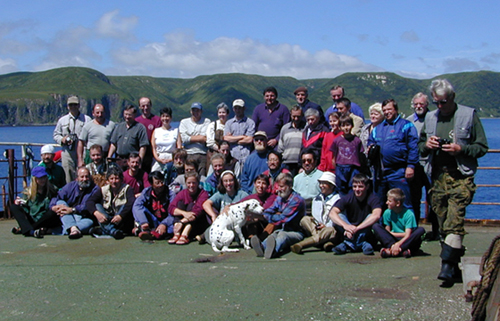 2000 IKIP participants on the deck of the R/V Ocean. Photo by Ben Fitzhugh.
|
|
RESULTS TO DATE.An international team of 31 scientists and students (see Project Participants, 2000 Expedition) met at Korsakov, Sakhalin Island, Russia, on 19 July 2000, boarded the 99-m Ocean, a research vessel of the Russian Academy of Sciences, and spent 24 days in the field. Twelve islands were visited: Shumshu, Paramushir, Onekotan, Kharimkotan, Shiashkotan, Raikoke, Matua, Yankicha, Simushir, Chirpoi, Brat Chirpoev, and Urup. Collections were made at 511 sites (see IKIP Databases and Map-based locality record browser) in widely varying habitats, similar to those collected in previous years (see Macro- and microhabitats of the Kuril Islands): from sea-level sandy-, rocky-beach, and grassland to high-mountain stream/conifer forest; from deep, slow-moving lowland rivers to fast-flowing gravelly streams; and from sphagnum bogs to high mountain lakes.
|
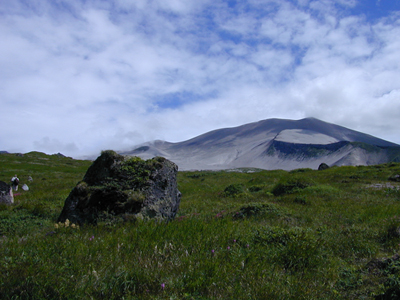 Windswept tundra-like terrain of the northern Kuril island of Kharimkotan. Photo by Trevor Anderson.
|
Collecting was confined primarily to lichens, vascular plants, aquatic and terrestrial insects, spiders and harvesters, freshwater and anadromous fishes, amphibians, and reptiles (collections of marine algae, mosses, liverworts, fungi, pseudoscorpions, decapods, water fleas, centipedes, millipedes, and marine fishes were also made). In addition to some bad weather, certain uncontrollable difficulties inherent in the project repeated themselves this year (such as impenetrable vegetation making adherence to transects impossible and difficult shore landings at some sites). However, the political problems we experienced in 1994 of gaining access to certain islands and to sites within islands did not reoccur. Our research vessel this year, the 99-m Ocean (the 68.8-m Professor Bogorov was used in 1994, 1995, and 1997; the 75-m Akademik Oparin in 1996, 1998, and 1999) was very comfortable and ably managed by Captain Yevgeniy A. Sklizkov and his crew of 42 (see Russian Research Vessels).
|
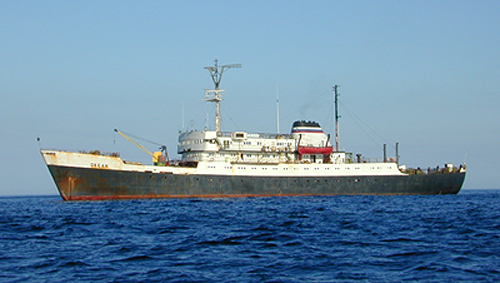 The 99-meter R/V Ocean commanded by Captain Yevgeniy A. Sklizkov, a vessel of the Russian Academy of Sciences. Photo by Trevor Anderson.
|
RESEARCH PRODUCTS.The greatly reduced number of biologists participating in this years expedition (less than half compared to previous expeditions, to make room aboard ship for archaeologists), and the considerably greater amount of field time devoted to archaeological activities, resulted in significantly fewer biological research products. Although counts are still preliminary, approximately 41,265 specimens were successfully exported to the U.S. (compared to 54,177 specimens exported in 1999; 63,235 in 1998; 53,155 in 1997; 63,700 in 1996; 45,080 in 1995; and 29,600 in 1994):
|
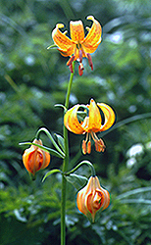 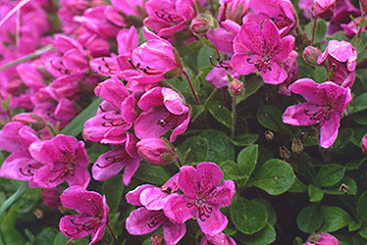 A lily Lilium medeoloides from Chirpoi (left) and a rhododendron Rhododendron camschaticum from Shiashkotan (right). Photos by Sarah Gage.
|
Lichens, mosses, liverworts, and plants: about 1,388 specimens of vascular plants, representing 42 families and at least 184 species; plus about 1,280 specimens of lichens and 495 bryophytes (mosses and liverworts), for a grand total of approximately 3,163 specimens; this material includes at least four new records of vascular plants for various islands and, among lichens and bryophytes, at least 12 new records for the Archipelago. Botanical highlights included a slope on Onekotan covered with different color morphs (pink, white, and magenta) of Orchis aristata, a heath on Kharimkotan covered with the tiny white flowers of Bryanthus gmelinii, and a bright yellow poppy (Papaver miyabeanum) growing in the gravel streets of an abandoned submarine base on Simushir.
|
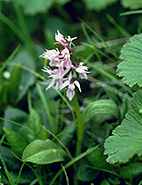 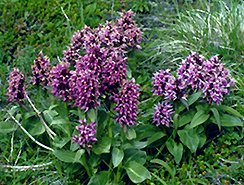 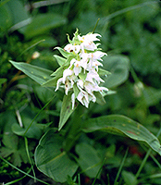 The three color morphs of Orchis aristata from Nemo Bay, Onekotan. Photos by Sarah Gage.
|
Terrestrial and aquatic insects: at least 32,500 specimens (but much remains to be sorted and countedthe final number could reach 45,000), representing 13 orders, about 90 families, and well in excess of 750 species (the absolute species number is probably much higher; to put things in better perspective, the number of known Kuril Island species of just one family of wasps, for example, the Braconidae, is 364); the material undoubtedly includes new taxa and many new records, but less than half the collection has been sorted to species and much is not yet even sorted to family.
|
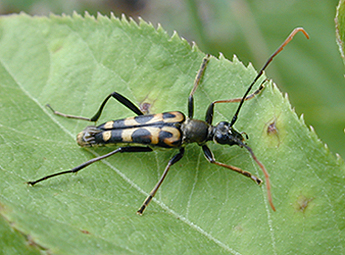 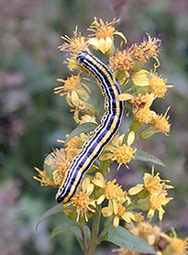 A cerambycid long-horned beetle from Iturup (left) and a caterpillar from Sakhalin (right). Photos by Dan Bennett.
|
Spiders and harvesters: about 640 specimens, representing 11 families and about 65 species; additional new records and perhaps new species may be expected, but most of the material remains unsorted and identified. Freshwater and intertidal fishes: 1,350 specimens, seven families, and 15 species, including two additional specimens of a new species of the cottid genus Microcottus (Yabe and Blackhart, in preparation). Amphibians and reptiles: 10 specimens, three families, and three species.
|
 Salamandrella keyserlingii Dybowski from the northern Kuril island of Shumshu. Photo by Trevor Anderson.
|
The plants, insects, spiders and harvesters, fishes, amphibians, and reptiles, are presently being processed here at the University of Washington in the Department of Botany, Burke Museum of Natural History and Culture, and School of Aquatic and Fishery Sciences. General oversight of plant curation is being coordinated by UW botanist Sarah Gage. Under her direction, all the vascular plants collected from 1995 (plants were not collected during our 1994 expedition; see the 1994 annual report) through 1998 have been identified and, with the assistance of graduate student Suzanne Joneson, work on the 1999 and 2000 collections is continuing. Most of the lichens from all years have been identified to genus, but the mosses and liverworts are yet to be examined in detail. In addition, all vascular plants collected in 1995 and over half of those collected in 1996 are mounted, accessioned, and filed in the University of Washington Herbarium where they are available for study and loan. The rest of the specimens collected in 1996 are in the queue for mounting and should be filed by mid-2001. General oversight of the insects (i.e., curation, loans and gifts of specimens, data compilation, etc.) is being coordinated by Brian K. Urbain (a veteran of IKIP since its inception); all entomological material will be eventually archived in the Department of Entomology at the California Academy of Sciences, San Francisco. Curatorial work on the vertebrates is well in hand, but much remains to be done with the plants, and other invertebrates despite great progress on insects during the past two years: under Brian Urbains direction, assisted by Daniel J. Bennett, undergraduate Elizabeth Freeman, and graduate student Sharon J. Collman (see Human Resource Development, below), all Hymenoptera and Coleoptera collected since 1994over 41,000 specimenshave now been fully curated (specimens pinned and labeled).
|
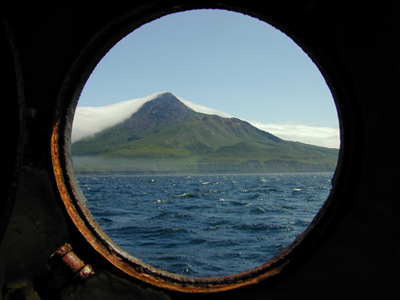 A view of the northern Kuril island of Onekotan from Trevor's porthole. Photo by Trevor Anderson.
|
Considerable time and effort has gone toward creating, maintaining, and updating an IKIP web-site, the heart of which is our search gateway to IKIP Databases: (1) Forms-based database search gateway, (2) Map-based locality record browser, and (3) Loans and Gifts of IKIP material (please note that our IKIP web-site was developed without the use of NSF funds). Over the past six years, we have worked hard to make all our data available electronically, but dealing with tens of thousands of specimens, it has been a major undertaking. All of our locality data, from 1994 through 2000, are on-line (6,775 sites on 30 islands, plus the mainland of Kamchatka) and we have entered 19,571 taxonomic records. To date, all of the following have been identified, cataloged, and made available on the web-site: all vascular plants, lichens, mosses, liverworts, Odonata, Plecoptera, aquatic Coleoptera, silphid Coleoptera, cerambycid Coleoptera, and Trichoptera collected from 1994 through 1998; Araneae (spiders), Opiliones (harvesters), Acari (mites), Lithobiomorpha (stone centipedes), Ephemeroptera, heteropteran Hemiptera, carabid Coleoptera, phorid Diptera, and formicid Hymenoptera collected from 1994 through 1997; all Cladocera, Dermaptera, Neuroptera, mymarid Hymenoptera, chrysolmelid Coleoptera, fishes, amphibians, and reptiles collected from 1994 through 1999; all Psocoptera, sternorrhynchan Hemiptera, and mollusks collected in 1994 and 1995; all histerid and cholevid Coleoptera collected in 1995; all syrphid Diptera collected in 1997; and all braconid and bethylid Hymenoptera collected in 1996 (see Table 1).
|
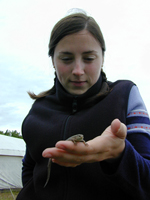 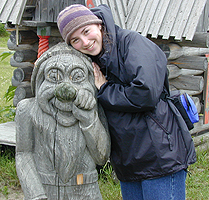 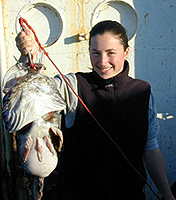 2000 REU participant Kristan E. Blackhart, a fisheries major at the University of Washington. Photos by Trevor Anderson (left, center) and Yuri Zhuravlev (right).
|
HUMAN RESOURCE DEVELOPMENT.Three University of Washington undergraduates, Kristan E. Blackhart (fishes), Trevor R. Anderson (terrestrial insects), and Cristie M. Boone (archaeology) (all supported by funds provided by Research Experiences for Undergraduates, see below), and three University of Washington graduate students, Suzanne L. Joneson (lichens, bryophytes, and plants), Christopher C. Lockwood (archaeology), and Scotty B. Moore (archaeology), all full participants in the 2000 expedition, received training in field work, curatorial practices, and systematics within their areas of interest. Their experience continues here at home as collections are being sorted and identified, and publications prepared. REU supplemental support received in 2000 was well used. One of the three recipients, Kristan E. Blackhart, now a senior fisheries major at UW, assisted in the collection of some 1,350 freshwater and marine fishes, which she helped to sort, label, and identify, nearly all of the work accomplished while still aboard the research vessel. She also spent considerable time collecting other taxa, including freshwater plankton, marine algae, terrestrial insects, and marine and terrestrial mollusks, as well as assisting the archaeologists in their excavations. Even prior to last summers expedition, Kristan showed a strong interest in fish systematics and ecology, working part time as a curatorial assistant in the UW Fish Collection, and since our return from the Kurils in August 2000, her interest has continued unabated. She has spent considerable time this autumn quarter curating IKIP fishes, concentrating especially on various sculpins that appear to be new to science. Mamoru Yabe, veteran of four IKIP expeditions and a world authority on these fishes, has invited Kristan to work with him in publishing reports on these new taxa. As a direct result of her participation in IKIP, she has just been awarded a prestigious UW Mary Gates Endowment for Students Research Training Grant that will allow her to pursue more fully her undergraduate research on Far East Russian fishes. In addition, she has just won the coveted Undergraduate Faculty Merit Award in the UW School of Aquatic and Fishery Sciences. Kristan is eager to continue her education and is now in the process of applying to various graduate schools around the country.
|
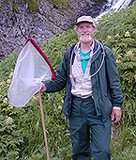 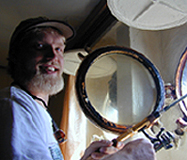  2000 REU participant Trevor R. Anderson, a University of Washington zoology major. Photos by Larisa Prozorova (left), Dan Bennett (center), and Trevor Anderson (right).
|
Trevor R. Anderson, the second recipient of 2000 REU support, now a senior zoology major at UW, assisted in the collecting, preserving, sorting, and identifying of terrestrial insects during the 2000 expedition, helping to bring back some 32,500 specimens. Following this summers work in the Kurils, Trevor, along with REU student Kristan Blackhart (see above) and IKIP veteran Dan Bennett (see below), spent two weeks collecting insects in southern Sakhalin, bringing back an additional 10,000 or so insects. Since our return from the Kurils in August, Trevor has put in about 20 hours of work per week curating insects, but also helping with the database and IKIP website. He too is eager to continue his education and is now looking for an appropriate graduate school.
|
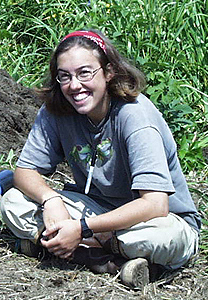 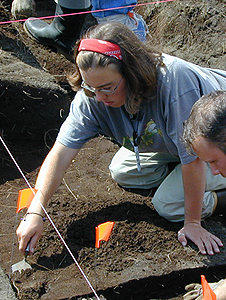 2000 REU participant Cristie M. Boone, a University of Washington anthropology major. Photos by Ben Fitzhugh (left) and Trevor Anderson (right).
|
For a summary of the contributions of Cristie M. Boone, the third recipient of 2000 REU support, see the IKIP Archaeology Report, compiled by Ben Fitzhugh and colleagues in the UW Department of Anthropology. Two veterans of the 1998 and 1999 expeditions, Suzanne L. Joneson (lichens, bryophytes, and plants) and Daniel J. Bennett (terrestrial insects) preformed brilliantly for us again this year. Throughout the year, Suzanne (now a first-year graduate student specializing in lichen systematics in the UW Department of Botany) continued to work with members of the Seattle Lichen Group to identify Kuril Island macrolichens; nearly all have now been identified to genus and many to species. In addition, she prepared a number of loans of lichens to specialists around the world and also entered locality and taxonomic data into the IKIP BIOTA/4D database used in the UW Herbarium. In preparation for the 2000 expedition, Suzanne used the database to compile complete lists of plants collected on each island during prior expeditions. These lists allowed us to focus our most recent collecting efforts on previously uncollected taxa. She also helped prepare and package botanical supplies and equipment for shipment to Vladivostok. During the expedition itself, Suzanne was a full participant, collecting 420 numbers (99 vascular plants, 299 lichens, and 22 bryophytes) in multiple replicates, resulting in over 1,680 specimens. She was energetic and enthusiastic in the field and in the ship's laboratory, where processing specimens and writing notes went on late into the night, seven days a week. This September, she shifted the focus of her graduate research at the UW Department of Botany to lichens. She is now working on a phylogenetic study of fistulose Ramalina along the northern Pacific coast under the supervision of Joe Ammirati. She is the lead author on a paper in preparation on Ramalina in the Kuril Islands.
|
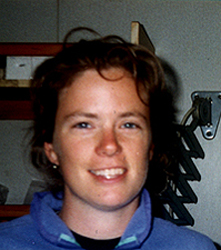 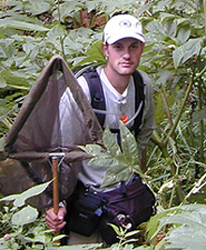 IKIP veterans, Suzanne L. Joneson, graduate student in botany; and Daniel J. Bennett, research assistant in entomology. Photos by Brian Urbain (left) and Trevor Anderson (right).
|
Although Daniel J. Bennett, a veteran of the 1998 and 1999 expeditions, graduated from the UW with a B.S. in Zoology in June 1999, his interest and participation in the Kuril Island Project has continued unabated. This past summer, he assisted in the collection of approximately 32,500 insects, which he helped to sort, label, and identify to order, much of the work accomplished while still aboard the research vessel. Following our work in the Kurils, Dan, along with REU students Trevor Anderson and Kristan Blackhart (see above), spent two weeks collecting insects in southern Sakhalin, bringing back an additional 10,000 or so specimens. Since our return from the Kurils in August, Dan has remained enthusiastic and committed to the project, working almost every day, seven days a week. While responsible over the past two and a half years for curating IKIP Hymenopterapersonally pinning more than 20,000 specimenshe has perfected the basic procedures of curation, from generating labels to pinning specimens, all the steps required to prepare insect material for permanent archival storage and professional research. At the same time, he has developed skills in specialized curatorial methods, such as critical-point drying of alcohol preserved insects, and microscopic glue-point mounting of our smallest and most delicate specimens. He is also corresponding and interacting with systematic entomologists around the world as we send various taxa out on loan for identification. He is now investigating graduate programs in entomologyhe plans to specialize in the Braconidae, a family of parasitoid wasps. It is important to emphasize once again Brian K. Urbain's contribution to IKIP, since its inception in early 1994 as Project Coordinator, has been extraordinary, especially in coordinating everything related to insects. He has not only organized and supervised the work of all personnel assigned to insects, but has spent untold hours of his own time as well sorting, identifying, and curating material. Early on in the project, Brian developed a strong interest in the Ichneumonidae (another family of parasitoid wasps) and has pinned and identified (to subfamily) nearly all members of this taxon collected in the Kurils over the past six years, more than 8,400 specimens. He is now deeply involved in a study of the scientific literature required to make species-level identifications.
|
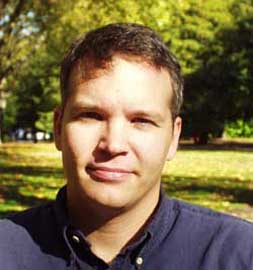  Christopher C. Lockwood and Scotty B. Moore, University of Washington graduate students in anthropology. Photos by Scotty Moore (left) and Ben Fitzhugh (right).
|
Although not members of the 2000 expedition, we received considerable help again this past year from four additional UW students: graduate student Sharon J. Collman (College of Forest Resources, Center for Urban Horticulture), and senior undergraduates Elizabeth Freeman (College of Forest Resources, Conservation of Wildland Resources), Jillian A. Kinghorn (Zoology) and Maria M. Ruud (Zoology). Sharon has been largely responsible for getting all IKIP Coleoptera, about 8,000 specimens, pinned and labeled; she has also been instrumental in preparing and making an inventory of the numerous insect loans that have been sent out over the last year. Elizabeths contributions to the project also include the preparation of loans, but her primary focus has been labeling insect specimens; to date she has labeled well over 10,000 specimens, mostly hymenopterans. Since early January 2000 and continuing through June, UW undergraduates Jillian Kinghorn and Maria Ruud have been working with spiders and various insects under the supervision of Rod Crawford at the Burke Museum. Despite this short time period, they have already received a diverse exposure to curatorial training. Most of their time has been spent sorting and identifying spiders, data-entry (incorporating taxonomic data on spiders into the IKIP database), cartographic plotting of collection localities, mounting butterflies and moths, and insect pinning and mounting. During the 1999-2000 academic year, we have also provided curatorial training and experience for a number of unpaid volunteers at the Burke Museum. The most productive of these individuals has been Janet Wall who continues to be immensely valuable to us in working with IKIP spiders and harvesters. Since January 2000, Janet has worked 122 hours, during which time she completed the task of identifying all spiders collected in 1998 and most of those collected in 1999. Largely through her efforts, all identified specimens from prior years are now arranged together in a systematic fashion, making it possible to immediately find any specimens needed for research or loans. Janet also processed loans and did other miscellaneous work during this reporting period. LOANS AND GIFTS.We have worked hard to make our material available to the international scientific community through loans and gifts of specimens. To date, we have made 130 loans and gifts (whole specimens as well as tissues fixed in ethanol) to 96 specialists around the world, totaling 6,289 lots and 56,194 specimens.
|
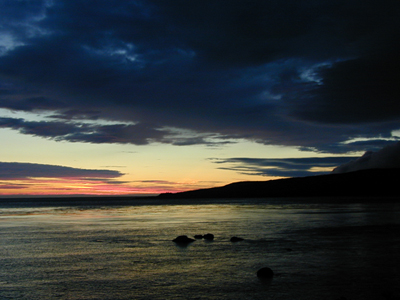 Sun setting on the central Kuril island of Matua. Photo by Trevor Anderson.
|
SEMINARS AND MEDIA ATTENTION.We have made a concerted effort to inform academic as well as public audiences about IKIP through oral presentation, and have received considerable attention from the media in return. To date, veterans of IKIP have presented 45 popular and scientific talks, and have been the subject of some 52 articles in newspapers and magazines. Our 1996 expedition was recorded in full by three employees of the Hokkaido Television Broadcasting Company (Yasumasa Shinomiya, writer; Osamura Hidetoshi, photographer; and Nikolai Shapotin, interpreter), resulting in a 30-minute television production that was aired in Japan on 2 March 1997. A 90-minute show on the people and general natural history of the Kuril Islands, which aired in April 1997, also featured IKIP-1996. Copies of these videos were made available to NSF in spring 1997. The 1997 expedition was recorded in full by South Korean Television, Soo Yong Park, Producer, but we have not yet received copies of the video. PUBLICATIONS.Eighty-seven papers have now been published. An additional six are in press, another three have been submitted, and about 20 are at various stages of preparation. Forty descriptions of new taxa have been published or are currently in press or submitted for publication: three new species of caddisflies (Trichoptera: Hydroptilidae, Leptoceridae), two new stoneflies (Plecoptera: Perlodidae), one new beetle (Coleoptera: Carabidae), six new flies (Diptera: Phoridae, Scathophagidae, Syrphidae), one new bug (Hemiptera: Miridae), ten new parasitoid wasps (Hymenoptera: Braconidae), one new genus and two new species of mites (Acari: Acaridae, Eviphidae), one new millipede (Diplopoda: Diplomaragnidae), six new freshwater bivalves (Bivalvia: Unionidae, Anodontidae), five new terrestrial and freshwater gastropods (Gastropoda: Planorbidae, Valvatidae), and three new fishes (Teleostei: Osmeridae, Cottidae, Gobiidae). Among our larger publication efforts is Y. N. Zhuravlev and A. S. Kolyada's book on the biology of ginseng published in 1996: Araliaceae: Ginseng and Other Aralia of the Russian Far East, Dalnauka, Vladivostok, 280 pp., 41 black and white figures, 8 color plates, 11 tables, and 859 bibliographic references. That portion of the book that covers Kuril Island species was funded in part by DEB-9400821 and DEB-9505031; NSF is properly acknowledged on page 1 of the front matter.
|
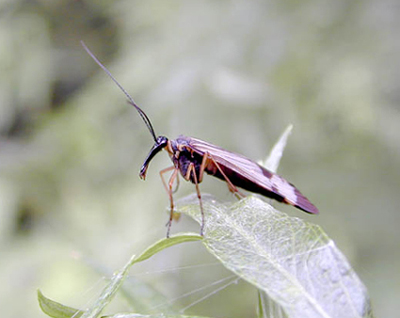 A scorpionfly Panorpa sp. (Mecoptera: Panorpidae) from Sakhalin. Photo by Trevor Anderson.
|
Our second larger publication effort, for which we received supplemental support from NSF, is an English translation of G. O. Kryvolutskaja's Entomofauna of the Kuril Islands, originally published in 1973 by the Institute of Biology and Soil Sciences, Far-Eastern Scientific Center, Russian Academy of Science, which is being edited, augmented, illustrated in color, and made available electronically. The book has now been completely translated by Elliott B. Urdang, M.D., M.A. in Russian, of Providence, Rhode Island, and all parts have been delivered to us by diskette and hard-copy: the Abstract, Preface, and Table of Contents (5 pages), Chapter 1, "History of investigations of the insect fauna of the Kuril Islands" (7 pages); Chapter 2, "General information on the insects of the Kuril Islands" (8 pages); Chapter 3, "Accounts of insect taxa of the Kuril Islands" (including methods and materials, keys, descriptions, and general taxonomic accounts by order; 130 pages); Chapter 4, "Ecological and geographic review of the Kuril Island entomofauna" (including physical conditions of the Kuril Islands, ecological features of the Kuril Islands, and insect assemblages and primary habitats of the Kuril Islands; 82 pages); Chapter 5, "Speciation on the Kuril Islands" (10 pages), Chapter 6, "Zoogeography of the Kuril Island entomofauna" (including geological history and floral evolution, zoogeographic origins and trends, and subdivision of the Kuril Archipelago based on insect distributions; 28 pages); Conclusions (4 pages); Summary (2 pages); Literature cited (15 pages), Index of scientific names of insects (19 pages); List of scientific and Russian names of plants (2 pages); all the tables (22); and the legends to all the figures (67). While some of the text requires additional editing, the entire book, including all figures and tables, is now available on the web-site. Color illustration of the work, with photographs taken by members of the IKIP insect team, is in progress. Similar plans to publish electronically V. Y. Barkalov's Plants of the Kuril Islands, are currently on hold while we await delivery of the manuscript. Although promised to us back in June 1997, his approximately 650-page work remains unfinished.
|
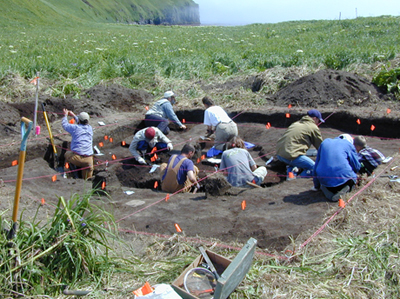 IKIP archaeologists hard at work excavating the remains of one of a cluster of 44 semi-subterranean pit-houses on the northwestern end of the central Kuril island of Chirpoi. Photo by Trevor Anderson.
|
PALEOBIOLOGY AND BIOGEOGRAPHY.As reported last year, one of the most exciting developments in recent years has been the discovery of several undisturbed archaeological sites on various islands throughout the Kuril Archipelago. To help assess the feasibility of a long-term, large-scale paleobiological and biogeographical study of the islands, IKIP (which was due to end with the 1999 field season) was extended another year, thanks to the foresight and generosity of the National Science Foundation. With this extension of IKIP into the year 2000 (see separate supplemental support requests submitted last year by Pietsch and Fitzhugh), we were able to capitalize on an unparalleled opportunity to explore the historical dimension of Kuril Island biodiversity and biogeography through archaeological survey and excavation. Detailed investigation of a number of sitesincluding the remains of a village containing 44 semi-subterranean pit-houses on Chirpoiwere conducted, as well as an archaeological survey of other islands in the chain to more fully document the history of human occupation in this remote and poorly studied Archipelago. Clearly there is enormous potential for future archaeological discovery in the Kurils. For more on archaeological activities, results, and plans for the immediate and long-term future, see the IKIP Archaeology Report, compiled by Ben Fitzhugh and colleagues in the UW Department of Anthropology.
|
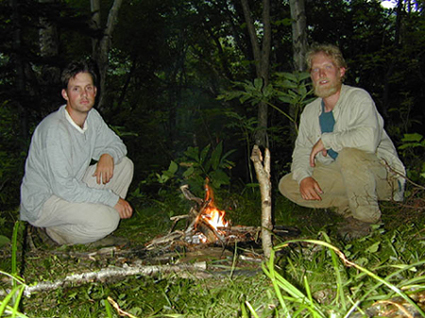 Research Assistant Daniel J. Bennett and REU student Trevor R. Anderson camping on southern Sakhalin Island. Photo by Trevor Anderson. |
NEW DIRECTIONS AND PLANS FOR SUMMER 2001. The enormous potential for
biotic survey in the Russian Far East has been demonstrated by our successful
seven-year effort in the Kuril Archipelago. With this experience now behind
us, we propose to put the Kuril work into the broader context of a long-term,
large-scale survey and inventory that encompasses all of Okhotskia, here
defined as the landmasses that surround and enclose the Sea of Okhotsk: (1)
the Kuril Islands in the southeast (now being surveyed as Phase 1), (2)
Sakhalin Island in the west (Phase 2, to start in summer 2001; see below),
(3) the Okhotsk coast of
southeastern Siberia (i.e., Khabarovsk and Magadan provinces) in the north
(Phase 3, a future proposal), and (4) Kamchatka in the northeast (Phase 4, a
future proposal). For more, see
|
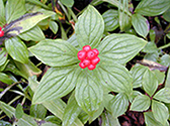 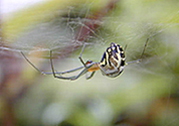 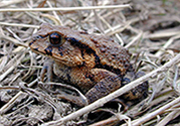 Bunchberry Cornus canadensis, a sheet-web weaver Neriene emphana, and a toad Bufo bufo, all from southern Sakhalin Island. Photos by Dan Bennett (left) and Trevor Anderson (center, right). |
As one of four primary source biotas for colonization of the Kuril Islandsthe others being Hokkaido, Kamchatka, and the Asian mainlandSakhalin is by far the least known biologically and in the greatest danger of over-exploitation. Narrowly separated from the continent for nearly 1,000 km and almost touching Hokkaido, Japan, at its southern tip, it forms a natural filter or barrier to dispersal of plants and animals from the Asian mainland to the Kurils. Although considerable information is available for wide-ranging, commercially important species, such as king crab, salmon, cod, and various marine mammals, the flora and fauna of Sakhalin as a whole are poorly known. At the same time, a steep rise in commercial exploitation of natural resources poses a serious environmental threat to the island. Viewing Sakhalin as a logical and much needed extension of our work in the Kurils, the National Science Foundation has already awarded first-year funding for the project (DEB 0071655), and we hope that our Russian and Japanese partners will be able to bring additional funding for an initial Sakhalin expedition in summer 2001: the Far East Branch of the Russian Academy of Sciences has pledged what support they might be able to provide and the Japan Society for the Promotion of Science is presently considering parallel support. Finally, in an effort to expand the work on Sakhalin to encompass a full five years, we have just submitted a new proposal to NSFs Biotic Surveys and Inventories Program. We eagerly await the results of the review process.
|
 Butterfly Inachis io (Linnaeus) resting on Rosa rugosa near Solov'evka village, South Sakhalin Island. Photo by Trevor Anderson.
|
With NSF funds (DEB 0071655) now in hand for an initial Sakhalin expedition in summer 2001 (approximately 20 July8 September), we will make a full circumnavigation of the island, collecting at no less than 10 major sites (a total of at least 10 transects). This initial full "overview" is required to help consolidate our ideas of how the work should best be parceled out during the succeeding four expeditions. Pending success of our proposal to extend the Sakhalin project for a full five years, and hoping that funds can be made available by 1 January 2002, a series of four annual expeditions will take place in July and August of each year of funding. In summer 2002, we will survey the southwest quarter of the island, encompassing the southern tip and all the territory that lies along the western slope of the Western Sakhalin Mountains as far north as the town of Aleksandrovsk-Sakhalinsk. In 2003, we will survey the northwest quarter, extending from Aleksandrovsk-Sakhalinsk to the mouth of the Bolshaya River on Baykal Bay. In 2004, we will survey the northeast quarter, from the mouth of the Bolshaya to Mount Lopatin and the northern terminus of the Eastern Sakhalin Mountain range. In 2005, we will survey the southeast quarter, covering the Tym-Poronaiskaya Valley and the outer and inner slopes of the Eastern Sakhalin Mountains. Thank you for the generous support we have received. We hope this brief report meets with your satisfaction.
|
![]()
